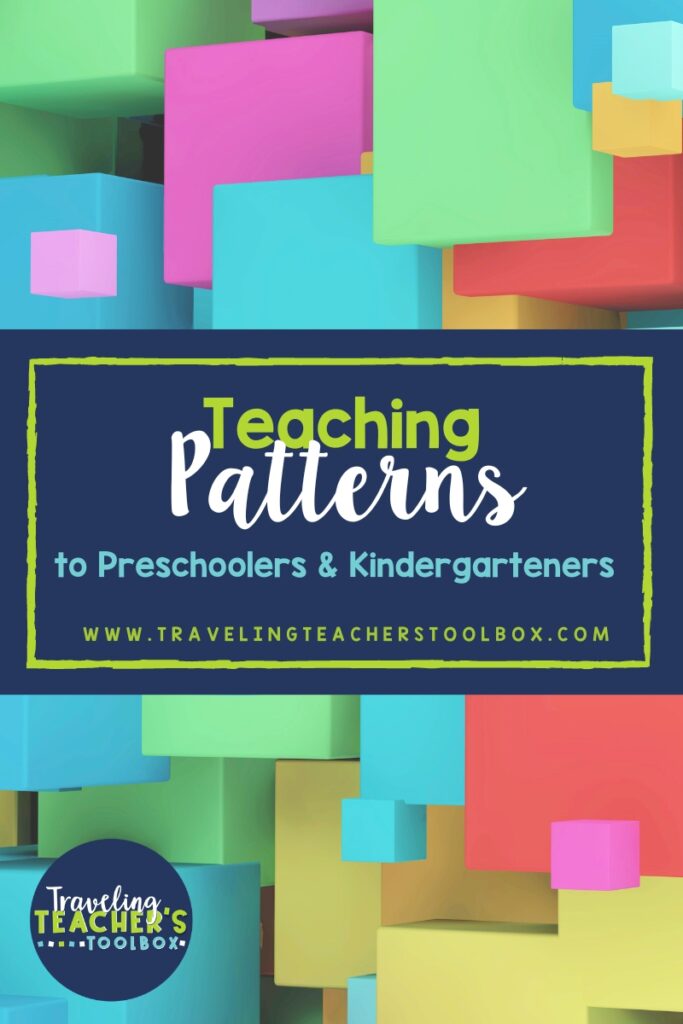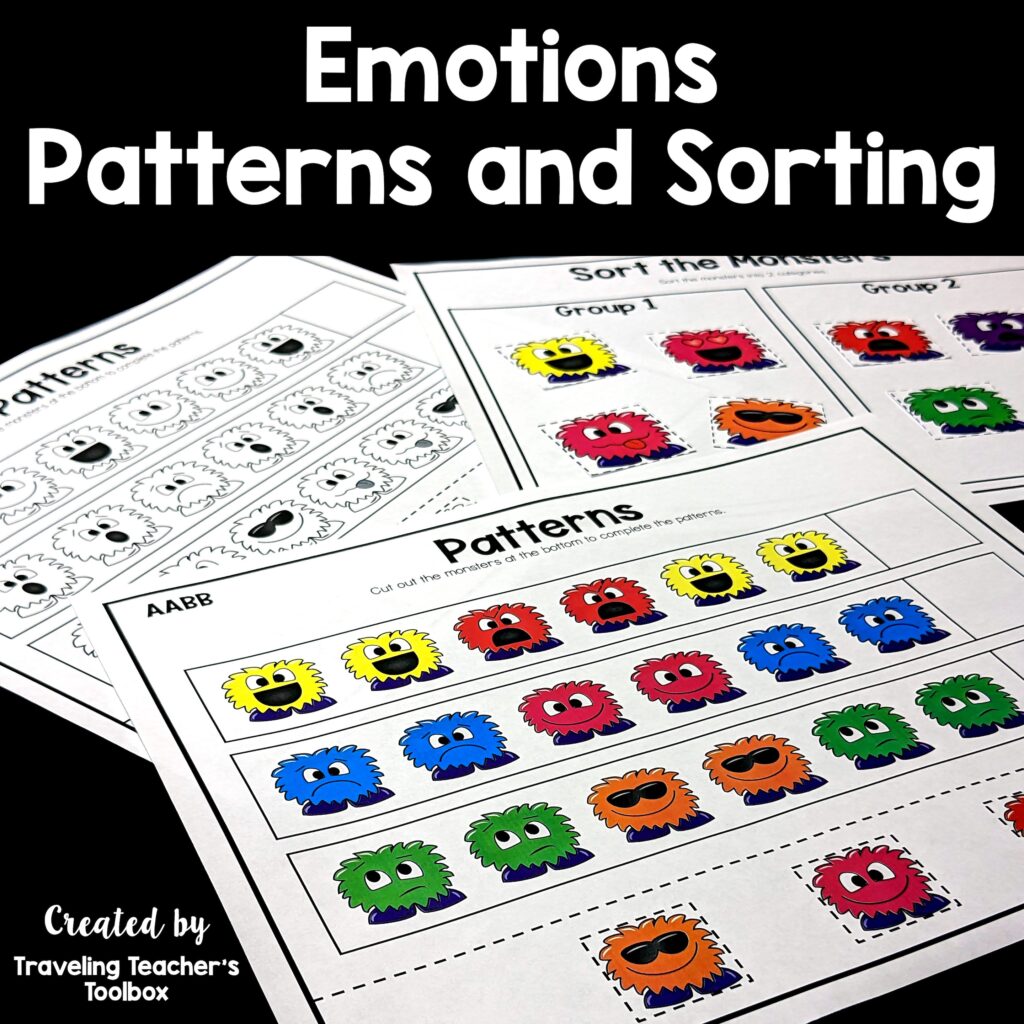Teaching patterns to preschoolers and kindergarteners is incredibly important. Have you ever thought about why?
While patterns are fun and can easily be incorporated into play, there are many benefits to learning about and working with patterns.
Keep reading to find out more about why patterns are important and how to teach them to your preschoolers and kindergarteners.

3 Reasons Why Teaching Patterns is Important
- Patterns are All Around Us: We are surrounded by patterns in nature. You can take your class outside and have them look around for patterns. They can be found in pine cones, flowers, bugs, and insects. Learning about patterns establishes a natural curiosity about the world around them and helps with skills such as observation.
- Developing Math Concepts: Patterns are often first taught with objects and images before using numerals. Not only does this help with spatial recognition, but as students advance, teaching patterns helps with a deeper understanding of the relationship between objects and numbers.
- Problem-Solving Skills: When working with patterns, kids will be asked to create their own patterns, fill in a blank space, and complete existing patterns. This will require them to use prediction and logical reasoning, which is great practice for developing problem-solving skills. These skills will not only serve kids in math but in their everyday lives as well.
Examples of Patterns to Teach
You should always start by letting students create their own patterns and explain them to you. But, once you have expert pattern makers, you can show and challenge your kids to make these:
- ABAB
- AABB
- ABCABC
- ABB
- AAB
You can also have students look at a pattern that is already created and tell you what that pattern is.
Another fun challenge is to start a pattern and have students complete it, or create a pattern but leave blank spaces for students to fill in the missing pieces.
Activities for Teaching Patterns in Preschool and Kindergarten
Books for Teaching Patterns
Books are a great way for kids to learn about anything, patterns included! Here are 3 books that make a great addition to learning about patterns.
1. Beep Beep, Vroom Vroom! by Stuart Murphy
This a great book about playing with cars that incorporates patterns. It is fun to read and would make a great addition to a transportation unit.
If you have toy cars in your classroom, a great extension to this story would be to have students line them up in a pattern after reading this story
2. Pattern Fish by Trudy Harris
This book gives students types of patterns to consider sorting such as shapes or colors. It has rhyming prose which makes it engaging as a read-aloud and has fun pictures!
3. I See a Pattern Here by Bruce Goldstone
This book provides many examples and goes into detail of patterns in real life. It even discusses how to make them. This is a great book to read or look at before having students find patterns around them.
It is non-fiction and may be a little long for a read-aloud in one sitting but can easily be read in separate sections for younger students. The pictures are wonderful!
Music and Movement for Teaching Patterns
Start by singing “If You’re Happy and You Know It” as a group. Then, break your students into 3 groups. Tell one group they are the clappers, one group they are the stompers, and one group they say “Hooray”! Point to each group and have them do their task (clapping, stomping, or saying Hooray) in a pattern.
Some examples:
- Clap, stomp, hooray, clap, stomp, hooray (ABCABC)
- Clap, clap, stomp, stomp, hooray, hooray (AABBCC)
- Clap, clap, stomp, hooray (AABC)
- Clap, stomp, stomp, hooray (ABBC)
- Clap, stomp, hooray, hooray (ABCC)
You can adapt by only doing the claps and stomps if you only have enough students for 2 groups, or you can add an extra option for a third group. The possibilities for different patterns here are endless.
Find Patterns in Real-Life
Walk around the classroom or even the playground and find real-life patterns that already exist. Then, when everyone is together again, have students share the patterns they found!
Make Pattern Bracelets
Gather some fun beads and pipe cleaners. Students make patterns on the pipe cleaners and describe them to you.
This activity makes a fun math addition to any holiday or seasonal celebrations you have in your classroom if you search for beads or colors that represent said holidays or seasons. Plus, students get something to take home with them!
Using Math Manipulatives for Teaching Patterns
Simply gather math materials you already have on hand and have students decide how to make patterns out of them. This is a great activity for an independent center or morning tubs.
Some examples of materials include:
- Pattern Blocks
- Math Links
- Math Cubes
- Counting Bears
- Building Bricks
- Stickers
- Stamps
- Mini Erasers
Students can choose to make patterns based on color, shape, size, or other ways they come up with on their own.
Cut-and-Paste Activities for Teaching Patterns
Cut and paste activities are important for learning how to use scissors and glue. They are also great for developing fine motor skills.
You can modify cut-and-paste lessons by cutting out the pieces for them and having students use them to complete the patterns or make their own.
Here is a great cut-and-paste patterns activity for kids. It also helps with social-emotional learning as students must determine what emotions are being shown in order to complete the patterns.
How do you teach patterns to your kiddos? I would love to see! Find or tag me on Instagram @tttoolbox and let me know!
Thanks for stopping by Traveling Teacher’s Toolbox!

